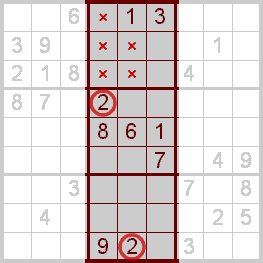If you don't know how to play read the previous post [How to play Sudoku? :) Its fun. It's challenging. It's adictive!]
There's no right or wrong place to start – but we do have to start somewhere, so let's look at the three boxes at the top of the puzzle.
There's a 1 in the middle box, and a 1 in the box on the right – but the box on the left still needs a 1. At first glance you might think the 1 could go into any of the four empty cells. However, the 1 cannot go in the top row of the box, because the top row of the grid already has a 1. A grid-row has room for only one of each number. Nor can the 1 go in the second row of the box because the second row of the grid already has a 1. There's only one place left for the 1 to go.
 Look for similar patterns elsewhere. You'll see something similar with the 2s in the stack of boxes down the middle. The top box doesn't have its 2 yet. There is a 2 in each of the center and bottom boxes, so we can rule out five of the seven empty cells in the top box. This is not quite the same situation as before, because there are two places the 2 could go. Some people just guess where the 2 should go, but it is better to use logic. It's best to have a reason why a particular number must go in a particular place.It's time to look in the other direction – at the rows of the grid, not just the columns. The third grid-row from the top already has its 2, so we can rule out one extra cell from the top box. Now there's only one place left for the 2 to go.
Look for similar patterns elsewhere. You'll see something similar with the 2s in the stack of boxes down the middle. The top box doesn't have its 2 yet. There is a 2 in each of the center and bottom boxes, so we can rule out five of the seven empty cells in the top box. This is not quite the same situation as before, because there are two places the 2 could go. Some people just guess where the 2 should go, but it is better to use logic. It's best to have a reason why a particular number must go in a particular place.It's time to look in the other direction – at the rows of the grid, not just the columns. The third grid-row from the top already has its 2, so we can rule out one extra cell from the top box. Now there's only one place left for the 2 to go.

Sometimes you can build on success. Let's see if that 2 leads us to success in the top-right box. After considering the rows, we can rule out only four of the seven empty cells. Even after considering the columns, we can rule out only five cells, still leaving two places for the 2 to go. Never mind, we learned something about where the 2 can go in the top-right box.

In fact, you might like to lightly pencil a small ‘2’ into each of the possible cells. In the Sudoku program these small numbers are called pencilmarks and they can be added and removed very easily.
Pencilmarks are useful reminders, but be sparing with them. Using too many can cloud the issues you are trying to clarify.
What next?
This technique on this page will get you launched into solving, but to finish a puzzle you may need to discover other techniques as well. Maybe you would prefer to make those discoveries on your own. It's certainly possible – you don't need to read or search for any more techniques on this stuff. So, if this page has sparked enough ideas for you to start solving right now, good luck and enjoy!

1 comment:
Thanks. That was helpful for a biginner like me. In fact I am hooked on .
Post a Comment